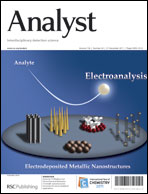Detection of
cell death has extensive applications and is of great commercial value. However, most current high-throughput cell viability assays cannot distinguish the two major forms of cell death: apoptosis and necrosis. Many apoptosis-specific detection methods exist but they are time consuming and labour intensive. In this work, we proposed a novel approach based on Matrix-Assisted Laser Desorption/Ionization Time-Of-Flight Mass Spectrometry (MALDI-TOF-MS) for the specific detection of apoptosis in cultured mammalian cells. Buffer washed cells were directly mixed with a matrix solution and subsequently deposited onto the stainless steel target for MALDI analysis. The resulting mass spectrometric profiles were highly reproducible and can be used to reflect cell viability. Remarkably, the mass spectrometric profiles generated from apoptotic cells were distinct from those from either normal or necrotic cells. The apoptosis-specific features of the mass spectra were proportional to the percentage of apoptotic cells in the culture, but are independent of the drugs used to stimulate apoptosis. This is the first report on the utilization of intact cell MALDI mass spectrometry in detecting mammalian cell apoptosis, and can be used as a basis for the development of a reliable, fast, label-free and high-throughput method for detecting apoptotic cell death.

You have access to this article
 Please wait while we load your content...
Something went wrong. Try again?
Please wait while we load your content...
Something went wrong. Try again?


 Please wait while we load your content...
Please wait while we load your content...